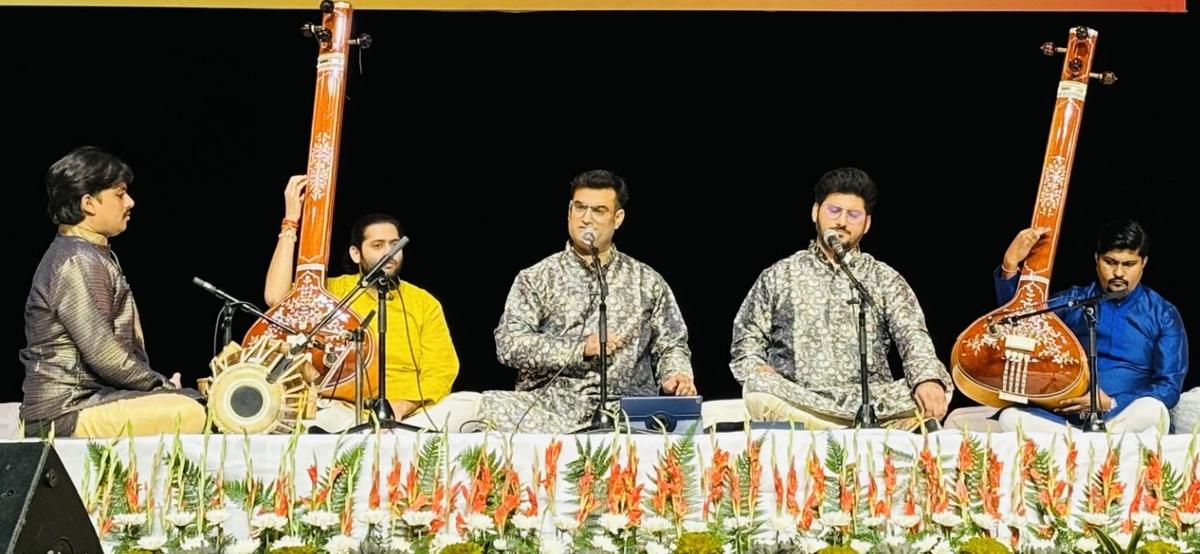The beautiful darbar hall in the erstwhile palace of Darbhanga, now the Kameshwar Singh Sanskrit University, has been the venue of many music concerts. The richly carved wooden peacocks connecting the walls with the roof are reminders of a bygone era. Likewise, the music that originated in Darbhanga, a city of great historical significance in North Bihar, has become a misty memory. But for the Mallicks, the dhrupad exponents, Darbhanga would have lost its presence on the country’s culture map. The family began its journey as court musicians. The later generations including Pt. Ram Chattur Mallick, Pt. Abhay Narayan Mallick and Pt. Vidur Mallick kept the legacy alive.
Now, a new generation of singers from the renowned lineage is making efforts to reach out to a wider audience.
Prashant and Nishant Mallick (grandsons of Pt. Vidur Mallick) have crafted a gayaki that has a contemporary feel to it even while being rooted in the authentic dhrupad style. Well trained, with a voice range of two-and-a-half octaves, the brothers impress with their sweeping meends.

Dhrupad singers Prashant Mallick and Nishant Mallick crafted a gayaki that has a contemporary feel to it.
| Photo Credit:
Special Arrangement
With a probing mind (both have done their doctorates), they have looked at ways to widen the repertoire, change the presentation style and revive elements lost to time. “Dhrupad is not as popular as khayal gayaki, and we wanted to change the perception. For instance, many find dhrupad’s aalap long-drawn-out and repetitive. It is one thing to hold on to tradition, but it is also important to help it reach new audiences. Afterall, an artiste wants to be heard,” says Prashant.
Change in style
Also, when they started singing around 25 years ago, dhrupad was dominated by the Dagar gayaki. A softer and more meditative style, Dagarvani had found an audience worldwide, with several of its practitioners dominating the world of dhrupad. Other styles of dhrupad were seldom heard. Hence, audiences were not familiar with the open-throated (‘mukth kanth gayaki’, where the voice production is from the navel) dhrupad singing of the Mallicks.
Prashant and Nishant share that this type of singing can invoke the ‘naad Brahma’, a reason why in the past dhrupad gayaks were referred to as ‘Naad Yogis’. “The emphatic layakaari and robust gamakas (they sing 15 types of gamakas) are unique too. Though the greats of our gharana are no more, we decided to popularise our style,” says Prashant.
The brothers also realised that the lack of sahitya in dhrupad was another significant reason for it to lose out on popularity to khayal and thumri. “I feel sahitya is important in vocal music,” says Nishant.
Documenting bandishes
For the past 50 to 60 years, dhrupadiyas have been singing the same set of popular compositions. This was not because there were just a few compositions; but because the approach to concert presentation was jaded. Around the year 2,000, when the Indira Gandhi National Centre for the Arts (IGNCA) was documenting bandishes in the same raag, Prashant recalled his father Pt. Prem Mallick recording more than 20 compositions in raag Aiman.
Specially-curated concerts

The Mallick brothers chose some of the padas of Swami Haridas and have set them to tune.
| Photo Credit:
Special Arrangement
Prashant shared, “We have tried to introduce sahitya in our concerts. Apart from the works of Tulsidas and the ‘Ashtachaap’ saints, we like poet Ashok Jamnani’s writing. We dug out some beautiful ‘kelimaal’ padas of Swami Haridas and set some of them to tune. Currently, we are recording verses from the Guru Granth sahib. Of course, it’s a challenge to understand the lyrics, which are in archaic Punjabi, and then compose the music in selected rare ragas mentioned in the holy scripture.”
The brothers are also setting to tune verses of Swami Muktananda (of the Swaminarayan tradition). “It’s exciting to take up such challenges. Specially curated concerts are the future,” say the duo.

Swami Haridas pada book cover
Another area they brought about change in were the raags. Since recorded history, dhrupad has always been sung in traditional ragas such as Bhairav, Todi, Aiman, Darbari and Malkauns (referred to as ‘shuddha’ ragas). “I felt, why not try singing in ragas such as Charukeshi, Hemant, Gaoti and Patdeep,” says Prashant. “My grandfather Pt. Vidur Mallick had started this in a small way, way back in the 1970s. We are doing this in a sustained manner. The audience should not feel that every time they have to hear the same raags in dhrupad. I feel even raags such as Bhairavi and Khamach Kafi used in thumris should be rendered in dhrupad style,” he adds.
Popular taals in dhrupad repertoire
Dhamar (14 beat cycle) is one of the most popular taals in the dhrupad repertoire but most compositions based on it are centred around the theme of Holi, and so, are not sung throughout the year. During a recent concert on Chaitra Purnima in Delhi, Prashant sang a beautiful composition on raas, which describes the joyful dance of Krishna and gopis. The raga too, appropriately was Sham Kalyan.
Prashant and Nishant have been experimenting with the enunciation of swaras, not merely singing aakar. “We don’t intend to dilute the essence and spirit of dhrupad, we just want to get more listeners to discover this beautiful style of music,” says Prashant.
Published – November 18, 2024 05:26 pm IST
#Meet #brothers #mission #popularise #dhrupad
